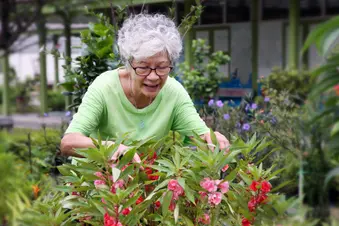
Staying mobile matters. Beyond physical activity, mobility helps us live life fully and on our own terms, especially as we grow older. It’s a key piece of maintaining independence, staying connected, and continuing to do what matters to us — whether that’s walking the dog, shopping at favorite stores, or meeting a friend for coffee. Research backs this up: regular movement can reduce the risk of falls, prevent injuries, support brain health, help manage chronic illnesses, and improve overall quality of life. Staying active is more than a lifestyle choice; it’s an important part of staying healthy, independent, and engaged as we age.
When Moving Is a Challenge
Mobility is more than getting from point A to point B. The older people get, the more important it is to maintain strength, balance, and coordination to reduce the risk of falls, the leading cause of serious injury and death among adults 65 and older. The benefits are more than just physical. Movement stimulates the brain and can help slow cognitive decline, boost mood, reduce feelings of isolation, and help older adults stay connected to the people and places they love.
Staying mobile is not easy or straightforward for some older adults. Many face serious barriers to maintaining their mobility, including chronic health conditions, pain, medication side effects, fear of falling, or a lack of safe spaces to exercise. But incorporating movement consistently, even in small ways, can make all the difference.
Easy Ways to Keep It Moving
Staying mobile is possible at any age, and it doesn’t require expensive equipment or taking 10,000 steps. Little adjustments, like moving more in your daily routine and trying gentle activities, can add up to a big difference. Here are some simple ways to keep moving:
Everyday movements count. Routine tasks can boost mobility. Everyday activities like carrying groceries, gardening, walking the dog, or doing household chores can help keep your body moving and your muscles engaged. This can improve your balance, strength, and confidence over time.
Low-impact activities. Exercises that are gentle on joints — such as tai chi, water aerobics, resistance band workouts, and chair yoga — can be just as effective as traditional routines. These activities improve flexibility, coordination, and muscle tone, and are often adaptable to different ability levels. Many of these activities also involve mindfulness practices that can help reduce stress and boost well-being.
Start small. Adding a little bit of movement each day — even just five minutes—can improve your endurance and strength. As you repeat these efforts, your body will adapt, making it easier to do more over time. Consistency is more important than intensity. Small, sustainable habits make a lasting difference.
Use trusted resources. The National Institute on Aging offers a wide range of free resources designed to help older adults stay active. These guides explain the benefits of physical activity, suggest safe exercises to try, and provide tips for overcoming common barriers like lack of motivation or fear of injury.
Review prescriptions regularly. Some medications can increase the risk of falls by causing dizziness, drowsiness, or confusion. Talk to your health care providers about all the medications you take — they may be able to adjust doses, recommend alternatives, or stop medications you no longer need. This small but critical step can make a difference in mobility and overall safety.
Talk to your health care provider about staying mobile and the 4Ms of age-friendly care. Mobility is one key part of your health to pay special attention to as you age. It’s one of the 4Ms of age-friendly care: What Matters, Medication, Mind, and Mobility. Before your next medical appointment, download My Health Checklist, a free 4Ms workbook designed to guide your conversation with your health care provider. Including mobility in your overall health plan will help you stay active and maintain your independence.
Movement Can Happen Anytime, Anywhere
You don’t need formal workouts or large blocks of time to stay active. Even small amounts of movement each day help build strength, improve balance, and support your mental health.
This week, challenge yourself to find one new way to move. The more you make activity a part of your daily routine, the more natural and enjoyable it becomes.
Each step, stretch, or movement is a step toward healthier, safer, and more enjoyable aging. Remember: Mobility is not just about staying active — it’s about staying engaged in life and the things that matter most to you.
Show Sources
Photo Credit: iStock/Getty Images
SOURCES:
Institute for Healthcare Improvement (IHI): “Age-Friendly Health Systems.”
JAMA: “Risky Prescribing and the Epidemic of Deaths From Falls.”
National Institute on Aging: “Health Benefits of Exercise and Physical Activity”
National Institute on Aging: “Exercising with Chronic Conditions.”
CDC: “Facts About Falls.”